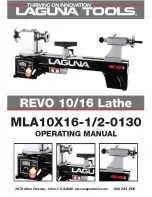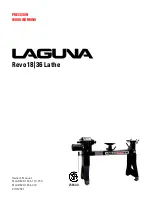
7
5. HEALTH & SAFETY INFORMATION
Wear personal protective equipment (PPE).
Dust, noise, vibration and swarf
can all be
dangerous if not suitably protected against. If the work involving the power tool creates dust
or fumes; wear a dust mask. Vibration to the hand, caused by operating some tools for
longer periods must be protected against. Wear vibration reducing gloves and allow long
breaks between uses. Protect against dust and swarf by wearing approved safety goggles or
a face shield. These are some of the more common hazards and preventions; however,
always find out what hazards are associated with the machine/work process and wear the
most suitable protective equipment available.
Do not breathe contaminated air.
If the work creates dust or fumes; connect the machine (if
possible) to an extraction system either locally or remotely. Working outdoors can also help
if possible.
Move the machine as instructed.
If the machine is hand held, do not carry it by the power
supply cable. If the product is heavy; employ a second or third person to help move it safely
or use a mechanical device. Always refer to the instructions for the correct method.
Do not overreach.
Extending your body too far can result in a loss of balance and you
falling. This could be from a height or onto a machine and will result in injury.
Maintain your tools correctly.
A well maintained tool will do the job safely. Replace any
damaged or missing parts immediately with original parts from the manufacturer. As
applicable; keep blades sharp; moving parts clean, oiled or greased; handles clean; and
emergency devices working.
Wait for the machine to stop.
Unless the machine is fitted with a safety brake; some parts
may continue to move due to momentum. Wait for all parts to stop; then unplug it from the
power supply before making any adjustments, carrying out maintenance operations or just
finishing using the tool.
Remove and check setting tools.
Some machinery requires the use of additional tools or keys
to set, load or adjust the power tool. Before starting the power tool always check to make
certain they have been removed and are safely away from the machine.
Prevent unintentional starting.
Before plugging any machine in to the power supply, make
sure the switch is in the OFF position. If the machine is portable; do not hold the machine
near the switch and take care when putting the machine down; that nothing can operate the
switch.
Carefully select an extension lead.
Some machines are not suitable for use with extension
leads. If the tool is designed for use outdoors; use an extension lead also suitable for that
environment. When using an extended lead, select one capable of handling the current
(amps) drawn by the machine in use. Fully extend the lead regardless of the distance
between the power supply and the tool. Excess current (amps) and a coiled extension lead
will both cause the cable to heat up and can result in fire.
Concentrate and stay alert.
Distractions are likely to cause an accident. Never operate a
power tool if you are under the influence of drugs (prescription or otherwise), including
alcohol or if you are feeling tired. Being disorientated will result in an accident.


























